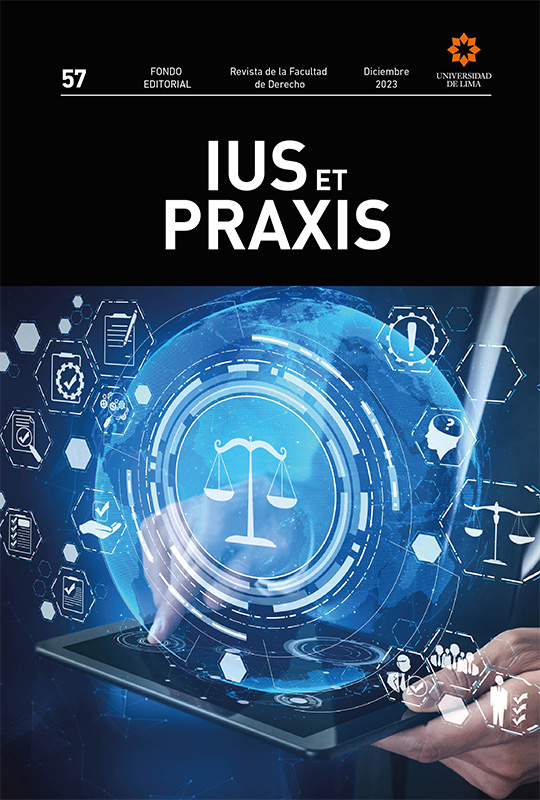Constitutional analysis of the legislation applicable to fake news in Peru
DOI:
https://doi.org/10.26439/iusetpraxis2023.n057.5962Keywords:
fake news, freedom of speech, social networks, right to information, cyberspaceAbstract
In the present article, the author analyzes the constitutional character of a regulatory framework against fake news in Peru. Likewise, it reviews the legislative advances in comparative law in order to contrast them in the light of the provisions of international treaties and revealing their excesses in relation to the right to freedom of speech. In addition, it criticizes the role assumed by social networks in the face of fake news, as well as the numerous collisions with the right to freedom of speech and other fundamental rights, due to the adoption of community policies on social networks. Based on the points mentioned, the author concludes by affirming the constitutionality of the regulation of fake news, insofar as they are considered an anomalous exercise of freedom of speech. Additionally, the author specifies the legislative technique, which he considers the most suitable for evaluating and delimiting the concepts and normative assumptions applicable to the case under study, avoiding the excesses of comparative legislation. In the same sense, it shows the deficiencies of the soft law, derived from the self-regulation of the media, proposing the application of other suitable means to combat disinformation in Peru.
Downloads
References
Abad Yupanqui, S. B. (2005). Libertades de expresión e información. En W. Gutiérrez (Ed.), La Constitución comentada: análisis artículo por artículo. (t. 1, pp. 104-113). Gaceta Jurídica.
Alvarado Carnero, L., & Diaz Ramos, V. (2020). Libertad de expresión y derecho a la información veraz: propuesta para limitar las fake news en Facebook [Tesis de bachillerato, Universidad Católica San Pablo]. DSpace. https://repositorio.ucsp.edu.pe/backend/api/core/bitstreams/448d58ad-9ba8-45bd-a8d0-75b33a992703/content
Alexander, L. A. (1993). Trouble on track two: incidental regulations of speech and free speech theory. Hastings Law Journal, 44(1), 921-962.
Baxter, A. S., Kenny, T., Finucan, L., & Yatim S. (2020, 1 de mayo). Free speech vs fake news: the future of content regulation. https://accesspartnership.com/free-speech-vs-fake-news-the-future-of-content-regulation/
Calvo García, M., & Picontó Novales, T. (2017). Introducción y perspectivas actuales de la sociología jurídica. Editorial UOC.
Castillo Lozada, G. D. (2021a). Plan de trabajo de investigación: el derecho a la libertad de expresión vs. fake news en el marco constitucional peruano [Manuscrito inédito].
Castillo Lozada, G. D. (2021b, 2 de julio). Entrevista a Julio César Mateus Borea [Manuscrito inédito].
Castillo Lozada, G. D. (2021c, 6 de julio). Entrevista a Aníbal Gonzalo Raúl Quiroga León [Manuscrito inédito].
Castillo Lozada, G. D. (2021d, 6 de julio). Entrevista a Ricardo Fabian Vallas Trujillo [Manuscrito inédito].
Código Penal. Decreto Legislativo 635 de 1991. 8 de abril de 1991. Diario Oficial El Peruano. https://spij.minjus.gob.pe/spij-ext-web/#/detallenorma/H682692
Comisión Europea de la Unión Europea. (2020). Proposal for a regulation of the European parliament and of the Council on a Single Market for Digital Services (Digital Services Act) and amending Directive 2000/31/EC.
Congreso Constituyente Democrático. (1993). Constitución Política del Perú de 1993. Diario Oficial El Peruano del 29 de diciembre de 1993. https://spij.minjus.gob.pe/spij-ext-web/#/detallenorma/H682678
Congreso de la República del Perú. (2020). Expediente del Proyecto de Ley 06567/2020-CR. https://www2.congreso.gob.pe/Sicr/TraDocEstProc/CLProLey2016.nsf/641842f7e5d631bd052578e20058a231/5f9b325c1da76486052586110066cb70?OpenDocument
Coronado Contreras, L. V. (2015). La libertad de expresión en el ciberespacio [Tesis doctoral, Universidad Complutense de Madrid]. Cisne. https://docta.ucm.es/rest/api/core/bitstreams/f51a1095-e7b6-41ec-abf7-b10a55d82c14/content
Gelfert, A. (2018). Fake news: a definition. Informal Logic, 38(1), 84-117.
Guerrero, L. A. H. (2010). Libertad de expresión: fundamentos y límites a su ejercicio. Pensamiento Constitucional, 14(14), 319-344.
Hartley, K., & Vu, M. K. (2020). Fighting fake news in the COVID-19 era: policy insights from an equilibrium model. Policy Sciences, 53(4), 735-758.
Kaye, D. (2017, 1 de junio). Mandate of the special rapporteur on the promotion and protection of the right to freedom of opinion and expression. Organización de las Naciones Unidas.
Lessig, L. (2002). Las leyes del ciberespacio. Thémis, (44), 171-179. Ley 1042 del 2020. Por la cual se previene, investiga, persigue y sanciona los delitos cometidos por medio de las tecnologías de la información y la comunicación. 27 de octubre de 2020. La Gaceta.
Ley 2630 del 2020. Pelo qual estabelece padrões, diretrizes e mecanismos de transparência para provedores de mídia social e serviços de mensagens privadas.
Ley 28278 del 2004. Por la cual se establece la Ley de Radio y Televisión. 16 de julio del 2004. Diario Oficial El Peruano. https://spij.minjus.gob.pe/spij-ext-web/#/detallenorma/H870310
Loi 2018-1202 du 2018. Relative à la lutte contre la manipulation de l’information. 22 décembre 2018. Journal officiel de la République française.
Parlamento Federal de la República Federal de Alemania. (2017). Newtork Enforcement Act - Netzwerkdurchsetzungsgesetz.
Schackmuth, A. (2018). Extremism, fake news and hate: Effects of social media in the posttruth era [Tesis de maestría, DePaul University]. College of Liberal Arts & Social
Sciences Theses and Dissertations. https://via.library.depaul.edu/etd/245
Tribunal Constitucional de Perú. Sentencia del expediente 0905-2001-AA-TC (Pleno jurisdiccional; 14 de agosto del 2002).
Tribunal Constitucional de Perú. Sentencia de los expedientes 0012-2018-PI-TC y 0013-2018-PI-TC (Pleno jurisdiccional; 11 de octubre del 2018).
United States Congress. (1996). Communications Decency Act of 1996, CDA.
Watzlawick, P. (1979). ¿Es real la realidad?: confusión, desinformación, comunicación. Herder.


